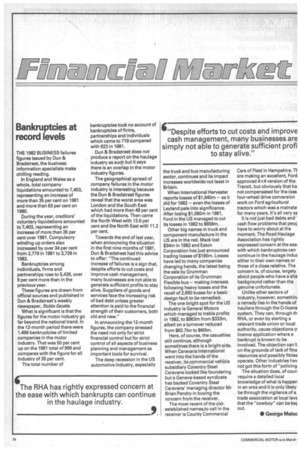Bankruptcies at record levels
Page 76

If you've noticed an error in this article please click here to report it so we can fix it.
THE 1982 BUSINESS failures figures issued by Dun & Bradstreet, the business information specialists make chilling reading.
In England and Wales as a whole, total company liquidations amounted to 7,403, representing an increase of more than 35 per cent on 1981 and more than 63 per cent on 1980.
During the year, creditors' voluntary liquidations amounted to 7,403, representing an increase of more than 35 per cent over 1981. Compulsory winding up orders also increased by over 34 per cent from 2,779 in 1981 to 3,728 in 1982.
Bankruptcies among individuals, firms and partnerships rose to 5,436, over 9 per cent more than in the previous year.
These figures are drawn from official sources and published in Dun & Bradstreet's weekly newspaper, Stubbs Gazette.
What is significant is that the figures for the motor industry go far beyond the national trend. In the 12-month period there were 1,496 bankruptcies of limited companies in the motor industry. That was 50 per cent up on the 1981 total of 999 and compares with the figure for all industry of 35 per cent.
The total number of bankruptcies took no account of bankruptcies of firms, partnerships and individuals which came to 719 compared with 623 in 1981.
Dun & Bradstreet does not produce a report on the haulage industry as such but it says there is an overlap in the motor industry figures.
The geographical spread of company failures in the motor industry is interesting because the Dun & Bradstreet figures reveal that the worst area was London and the South East which had more than 48 per cent of the liquidations. Then came the North West with 13.6 per cent and the North East with 11.2 per cent.
Towards the end of last year, when announcing the situation in the first nine months of 1981, Dun & Bradstreet had this advice to offer: "The continued increase of failures is a sign that, despite efforts to cut costs and improve cash management, many businesses are not able to generate sufficient profits to stay alive. Suppliers of goods and services face the increasing risk of bad debt unless greater attention is paid to the financial strength of their customers, both old and new."
In announcing the 12-month figures, the company stressed the need not only for strict financial control but for strict control of all aspects of business planning and management as important tools for survival.
The deep recession in the US automotive industry, especially the truck and bus manufacturing sector, continues and its impact increases worldwide not least in Britain.
When International Harvester reports losses of $1,640m — as it did for 1982— even the losses of 'Leyland pale into significance. After losing $1,060m in 1981, Ford in the US managed to cut its losses in 1982 to $658m.
Other big names in truck and component manufacture in the US are in the red. Mack lost $34m in 1982 and Eaton Corporation has just announced trading losses of $190m. Losses have led to many companies changing hands, the latest being the sale by Grumman Corporation of its Grumman Flexible bus — making interests following heavy losses and the recall of 2,650 buses for a basic design fault to be remedied.
The one bright spot for the US industry is General Motors which managed to treble profits in 1982, to $963m from $333m, albeit on a turnover reduced from $62.7bn to $60bn.
Here, of course, the casualties still continue, although sometimes there is a bright side. When Caravans International went into the hands of the receiver, its commercial vehicle subsidiary Coventry Steel Caravans looked like foundering but a Geneva-based syndicate has backed Coventry Steel Caravans' managing director Mr Brian Pendry in buying the concern from the receiver.
The most recent of the oldestablished names.to call in the receiver is County Commercial Cars of Fleet in Hampshire. IF are making an excellent, Ford approved 4x4 version of the Transit, but obviously that ha not compensated for the loss four-wheel drive conversion work on Ford agricultural tractors which was a mainstas for many years. It's all very sa It is not just bad debts and cash flow problems that peop have to worry about at the moment. The Road Haulage Association has rightly expressed concern at the easi with which bankruptcies can continue in the haulage indus either in their own names or those of a close relative. The concern is, of course, largely about people who have a sha background rather than the genuine unfortunate.
Unlike other sectors of industry, however, somethini a remedy lies in the hands of hauliers through the 0-licens system. They can, through th RHA, or even by alerting a relevant trade union or local authority, cause objections a licence application where a bankrupt is known to be involved. The objection can b on the grounds of lack of fina resources and possibly fitnes operate. Other industries hay not got this form of "policing The situation does, of coun require a detailed local knowledge of what is happen in an area and it is only likely be through the vigilance of a trade association at local levE that the "cowboy" can be kap out.
• George Malec












































































































